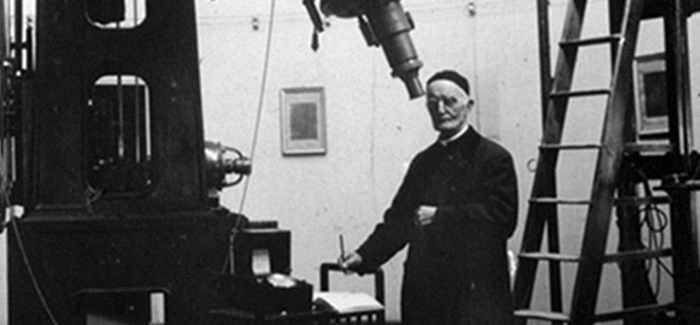
Johannes Hagen directed the Vatican Observatory in the early 20th century. (Photo courtesty Vatican Observatory)
For Jesuit priest Paul Mueller, SM’96, PhD’06, the same source reveals scripture and nature.
In his senior year at Boston University, Paul Mueller, SM’96, PhD’06, was “flipping coins” to decide between two paths. One led to the Jesuits and taking holy orders; the other led to a doctorate in physics.
The Jesuits won out, but Mueller’s work covers both sides of the coin. He currently serves as the religious superior and a member of the research staff at the Vatican Observatory.
As a priest in training, he earned three master’s degrees over 11 years (in philosophy, theology, and divinity) before being ordained. Throughout Mueller’s religious training, his superiors encouraged him to go back into science. “When someone’s capable of doctoral studies,” he says, “they tend to give the push and support to do it.”
He acted on their encouragement, but his interests had shifted. “By that time, Jesuit training had ruined my mind with philosophy and theology to the point where I didn’t want to do straight physics anymore,” Mueller says. So he enrolled in UChicago’s Conceptual and Historical Studies of Science program.
He earned a fourth master’s degree (this one in physics, a requirement for the UChicago program) before completing his doctorate in the philosophy of science in 2006. After a stint teaching philosophy at Loyola University, Mueller was appointed in 2010 to his post at the Vatican Observatory. He did not seek out the assignment, but his Jesuit superior who had the final say consulted him before making the decision.
In 1891 Pope Leo XIII founded the modern incarnation of the Vatican Observatory, which served to mitigate the Catholic Church’s image as antiscience and antimodernity after the papacy of Pius IX. First in Rome, the observatory later moved to Castel Gandolfo, the papal summer retreat outside the city. In 1993 the observatory built a more modern telescope at an Arizona facility it had founded in 1981, while still maintaining the Castel Gandolfo site. At both locations, the observatory staff, all Jesuit priests or brothers with PhDs, carries out research in planetary astronomy and cosmology, in addition to running a biennial summer school for international students.
“Supporting a search for truth,” Mueller says, is a defining principle for the church, whether it’s at the observatory or at Catholic universities that date back centuries. “It’s actually in the founding document of the observatory that it’s important for the Catholic Church to be showing its goodwill and active participation in the world of science out of respect for the fact that it is a search for the truth.”
Mueller describes the remodeled Castel Gandolfo monastery, where all the observatory’s full-time research staff members live, as “simple, functional, and homey.” As the observatory’s religious superior, Mueller oversees the staff’s home and spiritual life, a role he likens to being a house mother. “I supervise the cook, make sure they get vacations, and make sure they’re praying,” he says. “And if they get in a fight I’m the referee.”
While Mueller doesn’t find the science and religion that intersect at the observatory incompatible, others don’t quite know what to make of it. Any conflict, as far as Mueller is concerned, is between fundamentalists on both sides—and that’s “bad religion and bad science.” Instead, he argues, religion and science are complementary: “We’re made to search for the truth, and science is part of that.”
The search for truth can lead to curious notions about the nature of spirituality and the universe. Observatory staff have fielded numerous questions over the years, including whether the observatory is “where the pope goes to talk to the aliens.” The director, Guy Consolmagno, was asked on a radio show, “Would you baptize an extraterrestrial?” Consolmagno and Mueller drew on such questions for their book, fittingly titled Would You Baptize an Extraterrestrial? ... and Other Questions from the Astronomers’ In-box at the Vatican Observatory (Image, 2014). (The short answer: “Only if he asks.”)
They’re not dumb questions, Mueller says. “They’re questions where the premise is not right. We try to back off the question and premises and shift to a better and deeper question.” They cover topics from Galileo to the star of Bethlehem to contradictions between the Genesis story and the big bang theory. Publishers Weekly calls the result “absolutely enlightening.”
Mueller finds enlightening thought prevalent in the long history of religious dialogue with science. His research, an outgrowth of his doctoral dissertation, focuses on the dawn of the modern scientific method in the 17th century. Scholars at that time, many of whom were clergy, used empirical methods that had been pioneered in the study of old manuscripts and applied them to the natural world.
This early science “looks very modern, in the sense of being very empirical and mathematical, but also looks very strange to us in terms of how they select and combine empirical observations,” Mueller says. “The typical explanation is to say, ‘Oh, they had some kind of religious ideology blinding them.’ I don’t think that’s right; I think there was a whole different logic going on.”
Part of the logic underlying the Vatican Observatory’s work dates back much further, to a theory of St. Augustine’s that Pope John Paul II called “the unity of truth.” Mueller describes it as “faith that, at the end of time, when finally we will be able to understand the world fully and to interpret the Bible correctly, we will find that there is no disagreement between science and faith.” Any perceived conflict, he adds, reflects our incomplete understanding of each.
“If God is the author of both books, scripture and nature, and God doesn’t disagree with God, once we understand them both well, they ain’t going to disagree.”
